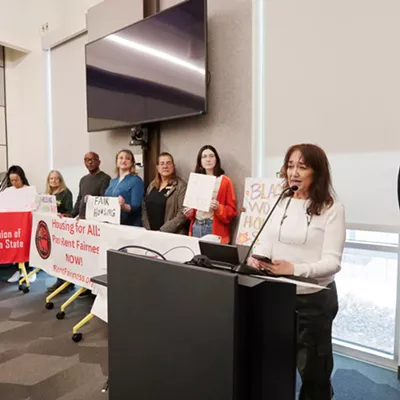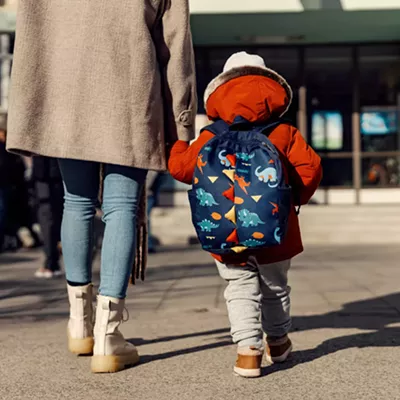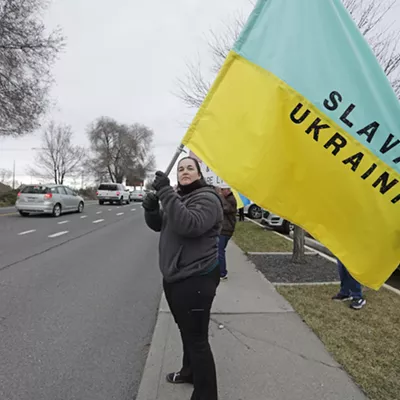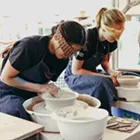Nothing is so firmly impressed on the mind of the visitor to Spokane... as the great gorge into which the river falls near the center of the city." That's what the Olmsted Brothers said when they came to Spokane in the early 1900s. In a report to the city's Parks Board, the famed landscape architects, who'd had a hand in designing Central Park, Stanford University and parks in Seattle and Portland, loved the falls. They called for the creation of a Great Gorge Park to preserve them as a civic centerpiece.
But this isn't a history piece. No, it's a future piece.
Because now, in an extraordinary case of delayed reaction, and after nearly a century of filling up, dumping in and boarding over the falls area, Spokane is finally considering taking the Olmsteds' advice.
This month, the Friends of the Falls, the nonprofit group that formed in opposition to the Lincoln Street Bridge back in 1997, is putting the final touches on a plan that they believe will be the fulfillment of the Olmsted Brothers' 100-year-old Great Gorge Park idea. On Oct. 27, the group will facilitate the last of two community workshops on the Great Spokane River Gorge Project before delivering a finalized master plan to the Parks Board later this year.
At its core, the Gorge Project is a collection of 15 priority projects that would improve existing facilities, provide better access to the river and create new ways for people to experience the gorge area between Spokane Falls and People's Park. "What we're trying to do with all this is get more people attached to the river," says attorney and Friends of the Falls chairman Doug Siddoway. "The more people we can get down to the river, the more sympathetic people are going to be to the river."
Though the list includes a number of smaller, foundational projects -- signs and wayfinding, the improved boat launch on Water Street -- others are downright grandiose. Perhaps the most buzzworthy is the plan to build a whitewater kayak course below the soon-to-open Sandifur Pedestrian Bridge near People's Park. Capitalizing on the recent success of similar parks in places like Reno and Steamboat Springs, the initial design calls for the creation of two "features" or "holes" -- chutes of whitewater created by anchoring huge hunks of native rock into the riverbed. There are also plans for a picnic area below the rapids and a kind of observation area on the Sandifur Bridge.
Gary Lacy, chief engineer for Recreation Engineering and Planning, a company that has built whitewater parks across the country, was hired by the Friends of the Falls to do a preliminary feasibility study on the Spokane River. "I was thoroughly impressed with the potential in the river itself," says Lacy. "It's waiting to happen, in my opinion."
He says that even though the Spokane River can trickle down to below 1500 cubic feet per second by midsummer, that's more than enough to create a dynamic course. "Those numbers didn't scare me in the least," he says. "In fact, I wish had those kinds of numbers where I live [in Colorado]." By staggering the elevations of the course's two features, he can assure that at least one will keep kicking throughout the summer, and potentially year-round. His preliminary design also suggested the possibility of a second course about half a mile upriver, off of Glover Field.
The other big project is a proposed Native American interpretive center. Though plans are still sketchy, and a real estate deal that might have housed the center at the former Salty's restaurant site fell through in 2002, members of the Kalispell and Upper Columbia United Tribes are discussing a collaborative effort. "Whatever direction [the tribes] decide to go works for the Master Plan," says Mike Terrell, a consultant for Friends of the Falls.
But the implications of these 15 priority projects could potentially reach far beyond rapids and trails. Since May, the Friends of the Falls have met with representatives from the city, the Parks Board, Avista, small businesses, neighborhood councils, and other interest groups to find ways in which the gorge projects might jibe with and spur on these stakeholders' own plans for the area. For example, the Centennial Trail links up with the Gorge Project's panoramic loop and lures more joggers and bikers to its own course. Rafting companies throw in their support and get whitewater access.
Proponents of the project suggest that many of the targeted neighborhoods, like West Central and Peaceful Valley, have been receptive to the idea. "They all appreciate the significance of bringing recreation to their doorsteps," says Doug Siddoway.
If the developers of the Summit Property ever recover from the implosion of Metropolitan Mortgage earlier this year, they could be one of the project's biggest winners. The property, a 78-acre sliver of land wedged between the river and the West Central Neighborhood, and stretching from the Monroe Street Bridge almost to the new Sandifur Bridge, lies in the heart of the proposed Gorge Project development area.
But before anyone starts zipping up their wetsuits, the Friends of the Falls must answer one rather difficult question: Who's going to pay for all this?
Though the group has scored hundreds of thousands of dollars in grants to fund the conceptual and master planning processes, the checks aren't rolling in yet for the implementation of the projects.
"We don't have any sources of funding for it," Siddoway says, noting that they won't begin raising dough for the next phase until the plan is officially endorsed. But with the city in the hole, the National Parks Service pinching its pennies, and the Spokane Park Board already in a million-dollar deficit for next year, full implementation of the plan -- a price tag, by some estimates, of $5 million -- won't be as easy as phoning a friend.
Siddoway says that the Friends of the Falls will try to ply the state legislature for cash, but adds, somewhat whimsically, "I just read in the New York Times that the Statue of Liberty was basically funded with private donations. That's what we're going to have to do here."
Mike Edwards, president of the Downtown Spokane Partnership, sounds chipper. He suggests that the economic and other benefits of the Gorge Project will more than justify the initial cost. "Business folks have seen the idea as something that would be available to the continued renaissance of downtown." He's particularly enthused about the kayak park and the tourism business it might bring to the city.
If you spend all day at a kayaking convention, he says, "and you arrive back at the Davenport still wet from your experience, [that's] a pretty compelling element to any convention in Spokane." Indeed, early studies suggest that the proposed kayak park alone could draw as many as three big events and $900,000 a year to the city.
Edwards sees the Gorge project as the catalyst for a new, green economy throughout the gorge: bait shops, outdoor retail, whitewater expedition, the kinds of places where "you go and get a cup of coffee before you go out on the water for the day." He says that the plan could bring entrepreneurial jobs and increased property values to struggling areas like West Central and Peaceful Valley: "This is a way to increase value in those neighborhoods."
Edwards and other proponents downplay the possibility of increasing property values driving out those who don't own property and can't keep up. "Certainly there is an awareness that if you're going to increase the attractiveness of a place, that could happen," he says. "We don't think those problems can't be addressed."
Provided that Friends of the Falls gains the city's, and the Park Board's, approval later this year, and pending the cash it will take to get it off the ground, it's clear that the Great Spokane River Gorge Project has the potential to make a mark on Spokane.
To offer up your two cents on the Great Gorge Park project, head to the final community workshop on Wednesday, Oct. 27, from 6-9 pm in the Champions Room of the Spokane Arena (720 W Mallon Ave.). For more information, visit www.friendsofthefalls.org.
PRIORITY PROJECTS
These 15 projects have been identified as steps toward the creation of a Great Gorge Park in downtown Spokane.
1. Signage/Wayfinding throughout the Gorge
2. Spokane Gorge Boulevard Panorama Loop
3. North Point Overlook
4. Confluence Area Visitor Arrival Point
5. Confluence Area Restoration
6. Westlink and North Overlook Restoration
7. Spokane River Gorge Loop
8. Centennial Trail Completion throughout the Gorge
9. Improvements to High Bridge Park Recreation Area
10. Kayak Course
11. Southern Gateway Development Area
12. Plateau Tribes Interpretive Center
13. Huntington Park Interpretive
Area and Wayfinding
14. Monroe Street Bridge Undercrossing
15. Improvements to informal
raft launch area on Water Street
Publication date: 10/21/04
















